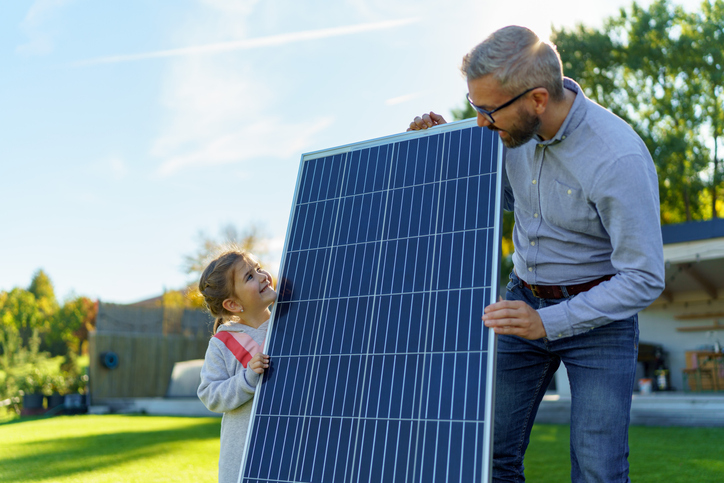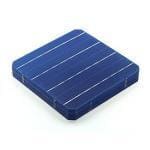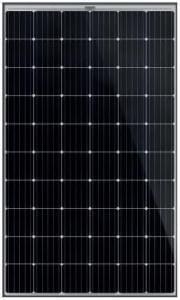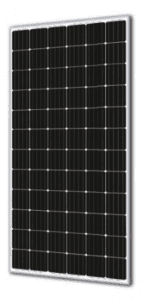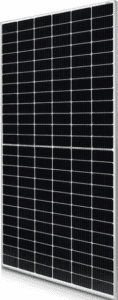There isn’t one single answer to the question “How big are solar panels?” but the size of the solar panels you install for residential or commercial solar systems matters.
For one thing, solar panel sizes or dimensions, measured in height by width, will determine exactly how many panels can fit on the roof space you have available. And how many panels you can install directly affects the electricity the solar system can generate.
In addition to the dimensions of the solar panels, the size of the panels in terms of power output or wattage (measured in Watts or W) will also come into play when working out how many panels you need to meet specific electricity generation requirements.
Solar Panel Sizes – How big are solar panels?
This is a question many homeowners ask when they are considering installing a solar system. The answer isn’t entirely straightforward.
There are two factors to consider:
- The dimensions of the panel – height x width measured in metres or centimetres.
- The maximum power output of the panel – measured in wattage, or ‘W’
The size of a solar panel will directly impact the number of solar cells that can fit onto the panel, which determines how much electricity can be generated from captured solar power.
Dimensions of solar panels differ depending on their use – for example, panels used in commercial installations tend to be larger than those used for residential installations, mainly because of larger roof spaces that can accommodate larger panels (and more of them).
Let’s consider some of these factors in more detail.
Solar cells
Solar panels are made up of solar cells, which are the ‘squares’ you can see on the panels. Cells use the photovoltaic effect to convert the energy of light directly into electricity. The more solar cells contained on a solar panel, the more power that panel can generate. Typically solar cell sizes have been 156mm x 156mm, however, they have been increasing over the last 3-4 years which has been leading to larger dimension solar panels.
Residential solar panel sizes
Standard residential solar panels contain 60 solar cells (or 120 half-cut solar cells) and typically generate anywhere from 350W to 500W of electricity. The size of these panels can range from 1.6m tall x 1.0m wide, to 1.7m tall x 1.0m wide.
Most residential solar panels are 1.7m tall x 1.0m wide (or 1.7 m2), with a maximum power output of around 330W.
Commercial solar panel sizes
Solar panels also come with 72 solar cells, which are larger to accommodate the additional cells. They are around 30% larger than residential solar panels, measuring approximately 2.1m tall x 1.1m wide (or 2.3 m2).
These 72-cell panels are used mainly for commercial solar arrays (with larger roof areas) or solar farms. Despite the naming convention, commercial solar panels can also be used on smaller residential roofs if they can fit on the available roof space.
In some cases, the purlin spacing and smaller size of 60 cells panels means you can fit an extra row of panels onto a residential roof which is why they are more commonly seen on residential projects.
Half-cell panels
You might also hear of 120 half-cell panels (equivalent size to 60 cells) or 144 half-cell panels (equivalent size to 72 cells). These half-cell panels, as you might suspect, have their solar cells cut in half. This leaves the output of the panel the same but reduces the electrical resistance in each of the cells leading to an efficiency gain for the solar cell. This is now a common technology deployed in most newer solar panel models.
They are similar in size and weight to their full-cell equivalents.
Solar panel output or ‘wattage’
The ability to capture the sun’s rays and generate power can differ between makes and models of solar panels. The wattage output (W) of the panels now usually varies between 350W and up to 500W. Power output per panel will determine how many panels you need to generate a desired amount of power.
For every 1kW of power your system needs to generate, it will need as many as three 350W panels, or as few as two 500W panels. For example, 6.6kW systems are very common for residential solar, so one of these systems will need 18 x 350W panels and 13 x 500W panels.
Greater wattage rating does not necessarily mean that the panel is better or newer than a lower rating. It is important to check the difference in dimensions of the panel and the maximum efficiency rating which should be shown on the datasheet.
Compare solar quotes from up to 7 local installers now.
How much roof space do you have?
This is the more important question to ask when looking at solar systems for your home – because roof space determines how many solar panels you can install, and the total electricity your system can generate.
The following table gives you an indication of the roof space you will need for different-sized solar systems made up of standard 1.7m2 solar panels, each with a power output of 330W and an allowance has been made for the additional space required to access and maintain the panels.
| Solar Panel System Size | Number of Solar Panels Required | Approximate Roof Space Required |
| 2kW | 6 | 12 m2 |
| 3kW | 9 | 17 m2 |
| 4kW | 12 | 23 m2 |
| 5kW | 15 | 28 m2 |
| 6.6kW | 20 | 38 m2 |
| 8kW | 24 | 45 m2 |
| 10kW | 30 | 55 m2 |
Each roof space needs to individually considered by a Clean Energy Council accredited designer to ensure that you have an optimal system that can be safely accessed and maintained. The above table serves as a guide only.
Are larger solar panels better?
Should you choose larger solar panels for your residential solar system? While they can be cheaper to purchase (with fewer panels required for the equivalent power output), there are some drawbacks.
Firstly, being around 30% larger than standard 60-cell panels, they can be harder to arrange efficiently on the roof of a house. Smaller spaces require smaller panels for the maximum panel-to-roof space ratio. For this reason, 60-cell panels are generally considered ‘residential solar panels’.
Secondly, they are also heavier, and therefore more difficult to carry and install (which may affect the installation cost).
Compare solar quotes from up to 7 local installers now.
What do solar panels weigh?
The weight of solar panels is important for a few reasons. Most important is the strength of the roof or structure onto which a solar system is to be installed. On top of that, the effort to carry and install the panels on a roof should also be considered.
A standard 60-cell 1.7m2 solar panel weighs around 18kg, while a 72-cell 2.3m2 module weighs around 23.5kg.
Not only are 72-cell solar panels heavier, but their extra height makes them more difficult to carry and manoeuvre, and they can also be more vulnerable to being caught by wind gusts when being installed.
How solar panel size and dimensions affects the system design
When it comes to designing a optimal solar system the solar panel size plays a key role:
- The height and width of each panel will determine how many solar panels can fit on your available roof space
- The power output or wattage per panel will dictate how many panels you need to generate the required amount of electricity
- The solar inverter input requirements will dictate how many panels can be connected together on each aspect of your roof face – which means some inverters may suit certain solar panels better than others
These are some of the things that a Clean Energy Council accredited solar designer would need to consider when designing the optimal system for your roof space. Designers are also often restricted by the solar panels their company sells, and they may be getting a bulk discount on certain brands.
The good news is that as solar technology continues to improve, power output per panel is increasing.
Over time, fewer panels are required to generate the same amount of electricity when compared to older solar panels. And fewer panels mean the system purchase cost can be lower, and less roof space is required for the solar array to be installed.
- Why a big battery could be cheaper than a small battery with the federal rebate? - 19 June, 2025
- Heat Pump Costs – Solar Choice Price Index - 1 June, 2025
- Solar Panel Costs: Solar Choice Price Index | June 2025 - 1 June, 2025
